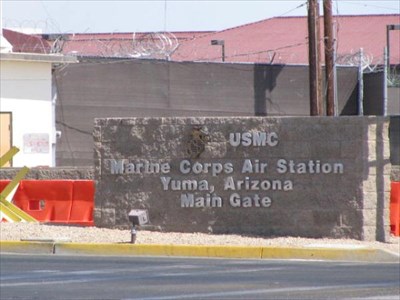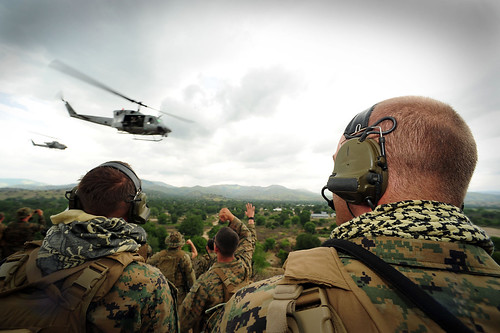I'm in Yuma, AZ. It's 11 PM and outside it has cooled down to 92 degrees, from a high of 112 earlier today. This morning's run wasn't too bad though - I'd guess it was around 80 at dawn which at about 1% humidity felt just fine.
We're here for three weeks supporting an exercise called Scorpion Fire. Its an aviation-focused exercise, designed to qualify both pilots and ground Marines to employ air assets. Since I (and apparently, you) have nothing better to do right now, let me explain.
One of the things the Marine Corps does best is "integrate fires," meaning use all available firepower (direct-fire weapons like rifles and machine guns, indirect fire weapons like mortars and artillery, and supporting fires like helicopters, planes and naval guns). In fact, doing so is critical to the Marine Corps way of fighting.
The idea is to put the bad guys in what's called a "combined arms" dilemma - if you stay where you are, you will be hit by my artillery or bombs, but if you get up to move, you will be hit by my rifles and machine guns. The catch is that artillery and bombs are indiscriminate. If you are a safe enough distance from the enemy to drop a 500lb bomb on them but you use the wrong nomenclature and call for a 2000lb bomb, you might have a bad day. Similarly, if you're dropping mortars on the bad guys and you bring in a helo to do a gun run without shutting off the mortars first, you may shoot down your own air support. This is generally frowned upon.
Combined Arms...literally. The M-16 is a direct fire weapon,
while the M203 grenade launcher (under slung) offers an
organic indirect fire capability to a unit as small as a fire team.
while the M203 grenade launcher (under slung) offers an
organic indirect fire capability to a unit as small as a fire team.
So what the Marine Corps trains hard at is becoming really good at coordinating and deconflicting these various forms of fire support, e.g. shutting off the mortars just in time for the helo, but not too soon so the enemy has a chance to reposition (flee), and not too late so you endanger your own aircraft. The Marines in charge of telling the aircraft what to do in these situations are called Forward Air Controllers (FACs) or Joint Terminal Attack Controllers (JTACs). The main purpose of Scorpion Fire is to qualify FACs and JTACs.
USMC JTACs
The cool twist is that FACs, in particular, don't have to be on the ground with the requesting unit. They can be pilots themselves - a Huey pilot (for example) can be a FAC(A) (the A stands for Airborne). He can be talking to someone on the ground to find out what they need, then tell an F-18 what to do, using his training as a FAC.
The business of telling pilots what to do is called "controlling." So for those of you who have heard me talk about my job, "controlling" aircraft, this is what I do. The difference is that I'm not a FAC or JTAC. My job is to talk to the pilot once he leaves the airfield and get him to his FAC or JTAC quickly and safely. As you can imagine, in a busy battle space like Helmand Province in Afghanistan, he may fly through the airspace of several different units on the way to his target. Each of those units may be using indirect fires, may have their own aircraft flying around at various altitudes, etc. My job is to "deconflict" the airspace, i.e. to tell him what route and altitude(s) to fly to get to his destination without crashing into another aircraft or interfering with what's going on above/below him.
And oh yeah...we do this without radar. We keep a sort of written log of where everyone is, as well as an electronic one for general situational awareness, but in reality we just have to keep the whole (constantly changing) situation in our heads. That's the part I find most fun and challenging.
airspace control concept, sorta.
Here at Scorpion Fire it's pretty easy - the pace of operations (number of aircraft in the air at once, number of fire missions, etc.) is quite manageable. In Afghanistan, there are often several dozen aircraft (including many unmanned platforms) at all kinds of altitudes, along with lots of fire missions (artillery, mortars, rockets, etc.) to avoid. As many of you will recall, my actual job in Afghanistan had nothing to do with all this - I was doing antiterrorism/force protection. But in my free time I went and controlled aircraft to keep up my skills and earn a qualification. Some days were slow, but some I had dozens of helos and unmanned aircraft I was controlling at once (someone else did planes) in very tight and congested airspace...not to mention civilian air (those crazy Russian pilots in their flying rust buckets).
Also, at Scorpion Fire all the flights are pre-planned. In Afg, many are as well ("this aircraft will support this unit from this time to that," or "this aircraft will resupply that unit at this time/location"), but many others are immediate requests, usually of the "send shooters now" or "send medevac now" variety. Immediate air requests are probably the most important part of what we do at the Direct Air Support Center (DASC), and certainly the most rewarding.
Whew! Hope you enjoyed that little tutorial. You're now well on your way to being a MAGTF (Marine Air-Ground Task Force) officer yourself! Which means you can probably come take over for me here in Yuma...
...now would be fine.












No comments:
Post a Comment